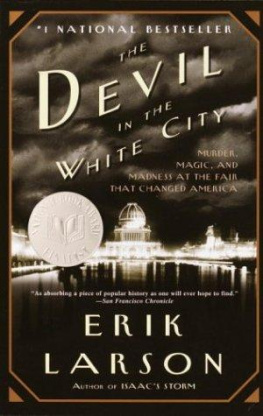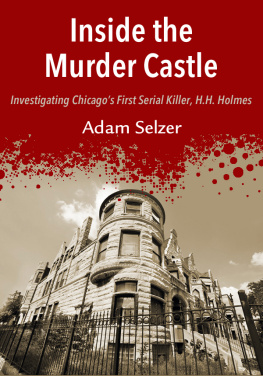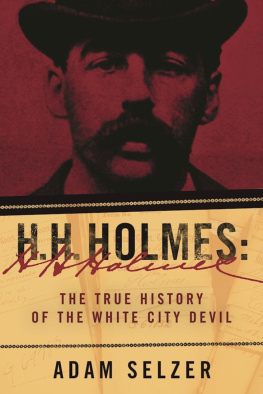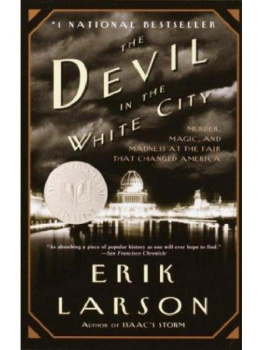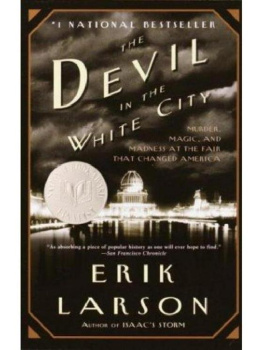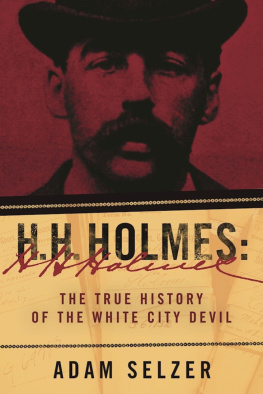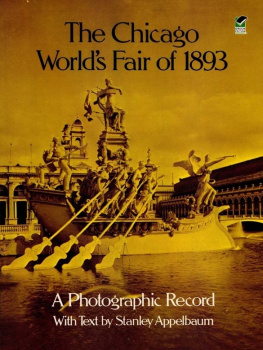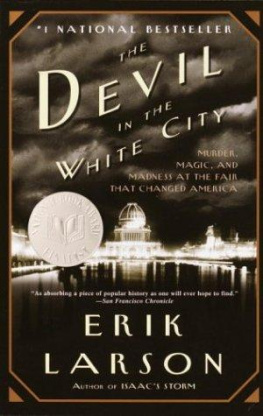The Devil in the White City
Erik Larson
To Chris, Kristen, Lauren, and Erin, for making it all worthwhile
and to Molly, whose lust for socks kept us all on our toes
Make no little plans; they have no magic to stir mens blood.
DANIEL H. BURNHAM
DIRECTOR OF WORKS
WORLDS COLUMBIAN EXPOSITION, 1893
I was born with the devil in me. I could not help the fact that I was a murderer, no more than the poet can help the inspiration to sing.
DR. H. H. HOLMES
CONFESSION
1896
Acknowledgements
THIS IS MY THIRD BOOK with Crown Publishers and with my editor, Betty Prashker, who once again proved herself to be one of New Yorks supreme editorsconfident, obliquely forceful, always reassuring. Every writer needs support, and she gave it unstintingly. Every book also needs support, and once again Crown marshaled a team of committed men and women to help the book find its way to as many readers as possible. Thanks, here, to Steve Ross, publisher; Andrew Martin, Joan DeMayo, and Tina Constable, marketing wizards; and Penny Simon, the kind of veteran publicist most writers wish they had but seldom get.
I have been blessed as well with one hell of an agent, David Black, a man whose instinct for narrative driveand excellent wineis unparalleled. He also happens to be an excellent human being.
On the homefront my family kept me sane. I could not have written this book without the help of my wife, Christine Gleason, a doctor by profession but also one of the best natural editors Ive encountered. Her confidence was a beacon. My three daughters showed me what really matters. My dog showed me that nothing matters but dinner.
Two friends, both writers, generously agreed to read the entire manuscript and offered their wise critiques. Robin Marantz Henig sent me a dozen pages of pinpoint suggestions, most of which I adopted. Carrie Dolan, one of the best and funniest writers I know, offered her criticisms in a way that made them seem like compliments. Hers is a knack that few editors possess.
Thanks also to Dr. James Raney, Seattle psychiatrist and forensic consultant, who read the manuscript and offered his diagnosis of the psychic malaise that likely drove Holmess behavior. Gunny Harboe, the Chicago architect who led the restoration of two of Burnham & Roots remaining buildingsthe Reliance and the Rookerygave me a tour of both and showed me Burnhams library, restored to its original warmth.
Finally, a word about Chicago: I knew little about the city until I began work on this book. Place has always been important to me, and one thing todays Chicago exudes, as it did in 1893, is a sense of place. I fell in love with the city, the people I encountered, and above all the lake and its moods, which shift so readily from season to season, day to day, even hour to hour.
I must confess a shameful secret: I love Chicago best in the cold.
Also by Erik Larson
Isaacs Storm
Lethal Passage
The Naked Consumer
About the Author
Erik Larson, author of the international best-seller Isaacs Storm, has written for Harpers, The New Yorker, The Atlantic Monthly, and Time Magazine, where he is a contributing writer. He is a former staff writer for The Wall Street Journal. He lives in Seattle with his wife, three daughters, and assorted pets, including a dog named Molly.

Chicago, 1891.
Evils Imminent
(A NOTE)
IN CHICAGO AT THE END of the nineteenth century amid the smoke of industry and the clatter of trains there lived two men, both handsome, both blue-eyed, and both unusually adept at their chosen skills. Each embodied an element of the great dynamic that characterized the rush of America toward the twentieth century. One was an architect, the builder of many of Americas most important structures, among them the Flatiron Building in New York and Union Station in Washington, D.C.; the other was a murderer, one of the most prolific in history and harbinger of an American archetype, the urban serial killer. Although the two never met, at least not formally, their fates were linked by a single, magical event, one largely fallen from modern recollection but that in its time was considered to possess a transformative power nearly equal to that of the Civil War.
In the following pages I tell the story of these men and this event, but I must insert here a notice: However strange or macabre some of the following incidents may seem, this is not a work of fiction. Anything between quotation marks comes from a letter, memoir, or other written document. The action takes place mostly in Chicago, but I beg readers to forgive me for the occasional lurch across state lines, as when the staunch, grief-struck Detective Geyer enters that last awful cellar. I beg forbearance, too, for the occasional side journey demanded by the story, including excursions into the medical acquisition of corpses and the correct use of Black Prince geraniums in an Olmstedian landscape.
Beneath the gore and smoke and loam, this book is about the evanescence of life, and why some men choose to fill their brief allotment of time engaging the impossible, others in the manufacture of sorrow. In the end it is a story of the ineluctable conflict between good and evil, daylight and darkness, the White City and the Black.
ERIK LARSON
SEATTLE
Prologue
Aboard the Olympic
1912

The architects (left to right) : Daniel Burnham, George Post,M. B. Pickett, Henry Van Brunt, Francis Millet, Maitland Armstrong, Col. Edmund Rice, Augustus St. Gaudens, Henry Sargent Codman, George W. Maynard, Charles McKim, Ernest Graham, Dion Geraldine.
Aboard the Olympic
THE DATE WAS APRIL 14, 1912, a sinister day in maritime history, but of course the man in suite 6365, shelter deck C, did not yet know it. What he did know was that his foot hurt badly, more than he had expected. He was sixty-five years old and had become a large man. His hair had turned gray, his mustache nearly white, but his eyes were as blue as ever, bluer at this instant by proximity to the sea. His foot had forced him to delay the voyage, and now it kept him anchored in his suite while the other first-class passengers, his wife among them, did what he would have loved to do, which was to explore the ships more exotic precincts. The man loved the opulence of the ship, just as he loved Pullman Palace cars and giant fireplaces, but his foot problem tempered his enjoyment. He recognized that the systemic malaise that caused it was a consequence in part of his own refusal over the years to limit his courtship of the finest wines, foods, and cigars. The pain reminded him daily that his time on the planet was nearing its end. Just before the voyage he told a friend, This prolonging of a mans life doesnt interest me when hes done his work and has done it pretty well.
The man was Daniel Hudson Burnham, and by now his name was familiar throughout the world. He was an architect and had done his work pretty well in Chicago, New York, Washington, San Francisco, Manila, and many other cities. He and his wife, Margaret, were sailing to Europe in the company of their daughter and her husband for a grand tour that was to continue through the summer. Burnham had chosen this ship, the R.M.S. Olympic of the White Star Line, because it was new and glamorous and big. At the time he booked passage the Olympic was the largest vessel in regular service, but just three days before his departure a sister shipa slightly longer twinhad stolen that rank when it set off on its maiden voyage. The twin, Burnham knew, was at that moment carrying one of his closest friends, the painter Francis Millet, over the same ocean but in the opposite direction.
Next page
